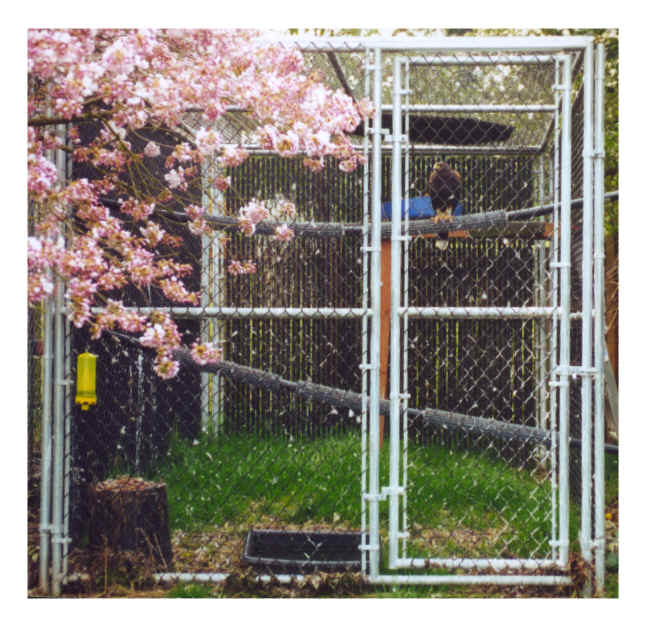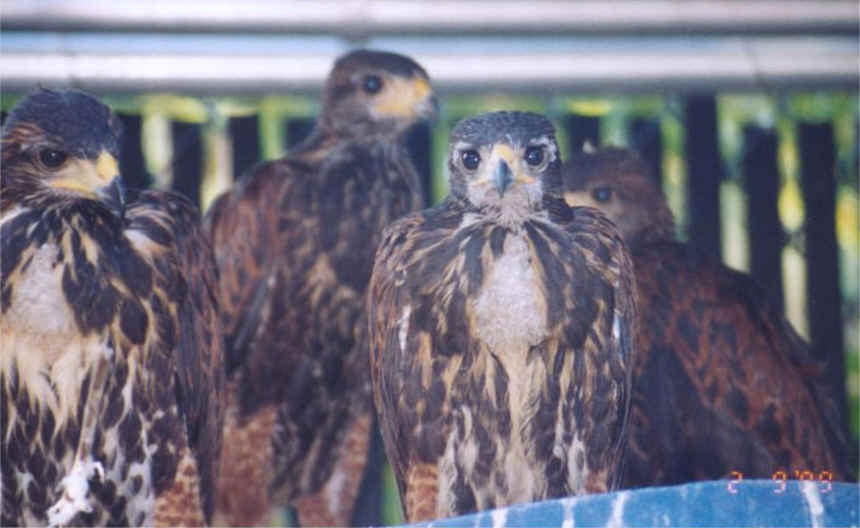Philosophy of breeding and
rearing Harris's hawks
Contact: Toby Bradshaw <baywingdb@comcast.net>
I
don't breed Harris's hawks for money, but rather to provide myself and my
friends with the best birds I can produce by selective breeding and careful
rearing of the young.
I
set high standards for my Harris's hawks.
The breeding pairs are chosen carefully for their proven ability in
falconry and for their kinship to other birds which have demonstrated superior
characteristics. A well-bred and
properly-reared Harris's hawk should be naturally tame and trusting.
It must be aggressive on game, including large and difficult quarry such
as jackrabbits. I expect the bird
to learn quickly the escape tactics of rabbits and hares, and to use its natural
gifts of speed and footing to best advantage.
A good Harris's hawk is a master of position in the field, taking a
commanding height when necessary to control large fields.
The bird is expected to work well with other Harris's hawks, without
crabbing or territorial behavior. Nearly
all
of my rabbit hunting is done over Jack Russells and other small dogs.
The bird must be absolutely trustworthy around dogs that are no bigger
than many of the quarry! I
don't claim that all the birds I produce are perfect, but they are the
result of a lot of thought, effort, and observation of hundreds of Harris's hawks
over the past 20+ years.
To
achieve all of these desirable traits in a captive-bred Harris's hawk requires
attention to both genetics and environment - nature and nurture.
As a university professor of genetics, I know that there are no shortcuts
in a selective breeding program. I
have chosen to concentrate my breeding efforts on two lines of Harris's hawks
which have exceptional qualities for falconry -- the Malcolm/White Wing line
originating with Tom and Jennifer Coulson, and the Harry/Harriet line
originating with Larry and Karen Cottrell.
 During
the breeding season, my hawks are kept in an open chain link enclosure with view
of
busy streets and backyards. Even
with this lack of privacy, the hawks are tame enough to copulate several times a
day, disregarding
lawnmowers, low-flying aircraft, and noisy children in the yard. Of
course, as the pairs rear their young, the eyasses are exposed to all the sights
and sounds of suburbia, making them exceedingly tolerant of people and disturbances
when they are trained. The parents
and young are fed primarily on
Coturnix quail sprinkled with Vitahawk.
Whole rabbits
from the previous hunting season and live mice are added for variety once the
young are out of the nest. All the young hawks are familiar with the appearance
of rabbits and have killed live mice before they are shipped, and I have had
no problems entering the hawks when they are trained.
During
the breeding season, my hawks are kept in an open chain link enclosure with view
of
busy streets and backyards. Even
with this lack of privacy, the hawks are tame enough to copulate several times a
day, disregarding
lawnmowers, low-flying aircraft, and noisy children in the yard. Of
course, as the pairs rear their young, the eyasses are exposed to all the sights
and sounds of suburbia, making them exceedingly tolerant of people and disturbances
when they are trained. The parents
and young are fed primarily on
Coturnix quail sprinkled with Vitahawk.
Whole rabbits
from the previous hunting season and live mice are added for variety once the
young are out of the nest. All the young hawks are familiar with the appearance
of rabbits and have killed live mice before they are shipped, and I have had
no problems entering the hawks when they are trained.
 I
generally allow
the breeding pairs to incubate their eggs and rear the young entirely on their
own. Occasionally I will extend a clutch by pulling eggs, artificially
incubating them, and rearing the young for 5-7 days before returning them to
the nest. It is very important that eyas Harris's hawks not be malimprinted
to people. Imprinted Harris' hawks cannot be flown with other Harris's
hawks, and nearly all imprints become dangerously aggressive towards people
(other than their 'mate') when they become sexually mature. Harris's
hawks, perhaps because of their long dependency period, seem unusually prone
to malimprinting. To
avoid malimprinting, and to permit the young birds to learn the nuances of Harris's
hawk social behavior that are necessary for successful group hawking, I
generally do
not separate the young from the parents before 16 weeks of age.
Parental discipline during the adolescent phase of Harris's hawk development
reduces crabbing and screaming when the bird is trained.
The young birds work out their social hierarchy, and recognize that none of
them is the dominant bird since the parents have that status. It
costs me more to feed the young for a month or two longer than most breeders do,
but you are rewarded with a better-behaved bird and lifetime hunting partner.
My dogs
are always sniffing around the bottom of the breeding enclosure looking for
scraps of food, so the young Harris's hawks treat them as part of the family. This familiarity with dogs
greatly reduces any worry that the hawk will be aggressive towards dogs, although
it is always advisable to take proper precautions when
first flying a young Harris's hawk with dogs.
I
generally allow
the breeding pairs to incubate their eggs and rear the young entirely on their
own. Occasionally I will extend a clutch by pulling eggs, artificially
incubating them, and rearing the young for 5-7 days before returning them to
the nest. It is very important that eyas Harris's hawks not be malimprinted
to people. Imprinted Harris' hawks cannot be flown with other Harris's
hawks, and nearly all imprints become dangerously aggressive towards people
(other than their 'mate') when they become sexually mature. Harris's
hawks, perhaps because of their long dependency period, seem unusually prone
to malimprinting. To
avoid malimprinting, and to permit the young birds to learn the nuances of Harris's
hawk social behavior that are necessary for successful group hawking, I
generally do
not separate the young from the parents before 16 weeks of age.
Parental discipline during the adolescent phase of Harris's hawk development
reduces crabbing and screaming when the bird is trained.
The young birds work out their social hierarchy, and recognize that none of
them is the dominant bird since the parents have that status. It
costs me more to feed the young for a month or two longer than most breeders do,
but you are rewarded with a better-behaved bird and lifetime hunting partner.
My dogs
are always sniffing around the bottom of the breeding enclosure looking for
scraps of food, so the young Harris's hawks treat them as part of the family. This familiarity with dogs
greatly reduces any worry that the hawk will be aggressive towards dogs, although
it is always advisable to take proper precautions when
first flying a young Harris's hawk with dogs.
For more information about the hawks
I breed, see: Pedigreed Harris's hawks For Sale page.
Toby Bradshaw's Hawking and
Falconry Website.
For more information on the Baywing Database,
contact Toby
Bradshaw.
Last revised: 15-Jul-2004
 During
the breeding season, my hawks are kept in an open chain link enclosure with view
of
busy streets and backyards. Even
with this lack of privacy, the hawks are tame enough to copulate several times a
day, disregarding
lawnmowers, low-flying aircraft, and noisy children in the yard. Of
course, as the pairs rear their young, the eyasses are exposed to all the sights
and sounds of suburbia, making them exceedingly tolerant of people and disturbances
when they are trained. The parents
and young are fed primarily on
Coturnix quail sprinkled with Vitahawk.
Whole rabbits
from the previous hunting season and live mice are added for variety once the
young are out of the nest. All the young hawks are familiar with the appearance
of rabbits and have killed live mice before they are shipped, and I have had
no problems entering the hawks when they are trained.
During
the breeding season, my hawks are kept in an open chain link enclosure with view
of
busy streets and backyards. Even
with this lack of privacy, the hawks are tame enough to copulate several times a
day, disregarding
lawnmowers, low-flying aircraft, and noisy children in the yard. Of
course, as the pairs rear their young, the eyasses are exposed to all the sights
and sounds of suburbia, making them exceedingly tolerant of people and disturbances
when they are trained. The parents
and young are fed primarily on
Coturnix quail sprinkled with Vitahawk.
Whole rabbits
from the previous hunting season and live mice are added for variety once the
young are out of the nest. All the young hawks are familiar with the appearance
of rabbits and have killed live mice before they are shipped, and I have had
no problems entering the hawks when they are trained. I
generally
I
generally